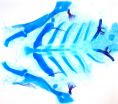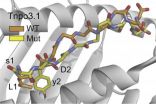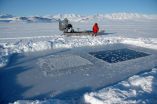(Press-News.org) In a big step for securing critical information systems, such as medical records in clinical settings, Dartmouth College researchers have created a new approach to computer security that authenticates users continuously while they are using a terminal and automatically logs them out when they leave or when someone else steps in to use their terminal.
Dartmouth's Trustworthy Health and Wellness (THaW)/ researchers recently presented their findings at the IEEE Symposium on Security & Privacy.
Common authentication methods based on passwords, tokens or fingerprints perform one-time authentication and rely on users to log out from the computer terminal when they leave. But users often do not log out, which is a security risk. The most common solution, inactivity timeouts, inevitably fail security (too long a timeout) or usability (too short a timeout) goals.
One solution is to authenticate users continuously while they are using the terminal and automatically log them out when they leave. Several solutions are based on user proximity, but these are insufficient: they confirm whether the user is nearby but not whether the user is actually using the terminal. Other proposed solutions based on behavioral biometrics (e.g., keystroke dynamics) may not be reliable, as a recent study suggests.
To address this problem, Shrirang Mare, a Dartmouth computer science Ph.D. student, developed an approach called Zero-Effort Bilateral Recurring Authentication, or ZEBRA. In ZEBRA, a user wears a bracelet with a built-in accelerometer, gyroscope and radio on his or her dominant wrist; such bracelets are commonly sold as fitness devices. When the user interacts with a computer terminal, the bracelet records the wrist movement, processes it and sends it to the terminal. The terminal compares the wrist movement with the inputs it receives from the user via keyboard and mouse and confirms the continued presence of the user only if they correlate. Because the bracelet is on the same hand that provides inputs to the terminal, the accelerometer and gyroscope data and input events received by the terminal should correlate because their source is the same – the user's hand movement.
In experiments, ZEBRA performed continuous authentication with 85 percent accuracy in verifying the correct user and identified all adversaries within 11 seconds. For a different threshold that trades security for usability, ZEBRA correctly verified 90 percent of users and identified all adversaries within 50 seconds. Thus, ZEBRA can recognize (in under a minute) when an unauthorized person steps in to use the terminal if the original user has stepped away from the terminal. This kind of quick reaction can prevent mistakes – such as clinical staff accidentally entering information into the wrong patient's medical record – or inappropriate behavior, such as a bystander examining personal medical information or financial data by taking advantage of a computer left open by an authorized user.
"In this work, we focused on the deauthentication problem for desktop computers because we were motivated by associated problems faced by healthcare professionals in hospitals," says the study's senior author Professor David Kotz. "It would be natural to extend ZEBRA to mobile devices, such as smartphones or tablet computers, and we believe this is possible despite some different challenges."
In principle, ZEBRA could also be extended to other devices such as TV remotes, game controllers or medical devices – any device where the user provides frequent inputs with his or her hand. For these devices, however, the application may be more for improving usability than security. For example, if the TV remote could identify who is holding it, it could provide personalized functionality, which could lead to a better user experience. Identifying who is using a particular medical device or sensor could help provide a secure user-attestation that is useful for healthcare professionals.
INFORMATION:
THaW is a $10 million research effort funded by the National Science Foundation, with Dartmouth as the lead institution. Kotz, of Dartmouth's Department of Computer Science and the Institute for Security, Technology, and Society, is the principal investigator.
Available to comment are Professor David Kotz at David.F.Kotz@dartmouth.edu and Ph.D. Candidate Shrirang Mare at Shrirang.B.Mare.GR@dartmouth.edu
Broadcast studios: Dartmouth has TV and radio studios available for interviews. For more information, visit: http://www.dartmouth.edu/~opa/radio-tv-studios/
Dartmouth's new ZEBRA bracelet strengthens computer security
2014-09-22
ELSE PRESS RELEASES FROM THIS DATE:
NASA sees Tropical Storm Fung-Wong move through East China Sea
2014-09-22
Tropical Storm Fung-Wong weakened over the weekend of Sept. 20-21 as it moved over Taiwan and approached Shanghai, China.
NASA's Aqua satellite captured an image of Tropical Storm Fung-Wong when it was approaching Taiwan on Sept. 20 at 1:35 a.m. EDT.
On Sunday, Sept. 21, Tropical Storm Fung-Wong was over Taiwan. It was centered at 26.0 north latitude and 122.0 east longitude, just 60 miles north-northeast of Taipei, Taiwan and moving to the north. Maximum sustained winds were near 50 knots (57 knots/92.6 kph).
By Monday, Sept. 22, Fung-Wong's center was approaching ...
University of Southern California researchers reveal how gene expression affects facial expressions
2014-09-22
A person's face is the first thing that others see, and much remains unknown about how it forms — or malforms — during early development. Recently, Chong Pyo Choe, a senior postdoctoral fellow working in the lab of USC stem cell researcher Gage Crump, has begun to unwind these mysteries.
In a September study published in the journal Development, Choe and Crump describe how a mutation in a gene called TBX1 causes the facial and other deformities associated with DiGeorge syndrome.
During prenatal development, a series of segments form that eventually organize many features ...
New 'star' shaped molecule breakthrough
2014-09-22
Scientists at The University of Manchester have generated a new star-shaped molecule made up of interlocking rings, which is the most complex of its kind ever created.
Known as a 'Star of David' molecule, scientists have been trying to create one for over a quarter of a century and the team's findings are published in the journal Nature Chemistry.
Consisting of two molecular triangles, entwined about each other three times into a hexagram, the structure's interlocked molecules are tiny – each triangle is 114 atoms in length around the perimeter. The molecular triangles ...
Fracking's environmental impacts scrutinized
2014-09-22
Greenhouse gas emissions from the production and use of shale gas would be comparable to conventional natural gas, but the controversial energy source actually faired better than renewables on some environmental impacts, according to new research.
The UK holds enough shale gas to supply its entire gas demand for 470 years, promising to solve the country's energy crisis and end its reliance on fossil-fuel imports from unstable markets. But for many, including climate scientists and environmental groups, shale gas exploitation is viewed as environmentally dangerous and ...
New rules for anticancer vaccines
2014-09-22
Scientists have found a way to find the proverbial needle in the cancer antigen haystack, according to a report published in The Journal of Experimental Medicine.
As cancer cells divide, they accumulate random mistakes (mutations). This process creates new versions of proteins, some of which are recognized as foreign invaders by immune cells called T cells, prompting the cells to attack and eliminate the cancer cells. With our current ability to identify all of the mutations in a patient's cancer and to understand which protein sequences can be recognized by T cells, ...
Classroom intervention helps shy kids learn
2014-09-22
A program that helps teachers modify their interactions with students based on an individual's temperament helps shy children to become more engaged in their class work, and in turn, improves their math and critical thinking skills.
Led by NYU's Steinhardt School of Culture, Education, and Human Development, the study offers an evidence-based intervention to help shy children, who are often at risk for poor academic achievement. The findings appear in the Journal of School Psychology.
Shy children are described as anxious, fearful, socially withdrawn, and isolated. ...
Arctic sea ice helps remove CO2 from the atmosphere
2014-09-22
Due to global warming, larger and larger areas of sea ice melt in the summer and when sea ice freezes over in the winter it is thinner and more reduced. As the Arctic summers are getting warmer we may see an acceleration of global warming, because reduced sea ice in the Arctic will remove less CO2 from the atmosphere, Danish scientists report.
"If our results are representative, then sea ice plays a greater role than expected, and we should take this into account in future global CO2 budgets", says Dorte Haubjerg Søgaard, PhD Fellow, Nordic Center for Earth Evolution, ...
Nurse survey shows longer working hours impact on quality of care
2014-09-22
Results of a survey of more than 30,000 nurses across Europe show that nurses who work longer shifts and more overtime are more likely to rate the standard of care delivered on their ward as poor, give a negative rating of their hospitals safety and omit necessary patient care.
Led by researchers at the University of Southampton and the National Nursing Research Unit (NNRU) at King's College London, the RN4CAST survey of nurses in over 450 hospitals across 12 European countries, was part of an international research programme looking at links between nursing workforce ...
Singapore researchers discover a gene that increases incidence of AML
2014-09-22
A novel study by the Cancer Science Institute of Singapore (CSI Singapore) at the National University of Singapore (NUS) found that an increase in a gene known as Leo1 affects other genes that are directly implicated in acute myelogenous leukaemia (AML), increasing the incidence of cancer.
Led by Associate Professor Chng Wee Joo, Deputy Director and Senior Principal Investigator at CSI Singapore and Director of the National University Cancer Institute, Singapore, the scientists discovered that inhibition of Leo1 and Leo1 downstream signalling pathways provide an avenue ...
New guidelines issued for managing peri- and postoperative atrial fibrillation
2014-09-22
Beverly, MA, September 22, 2014 – The American Association for Thoracic Surgery (AATS) has released new evidence-based guidelines for the prevention and treatment of perioperative and postoperative atrial fibrillation (POAF) and flutter for thoracic surgical procedures. The guidelines are published in The Journal of Thoracic and Cardiovascular Surgery.
"These guidelines have the potential to prevent the occurrence of atrial fibrillation in thousands of patients who undergo lung surgery in the United States each year. The AATS is committed to its goal of improving the ...



